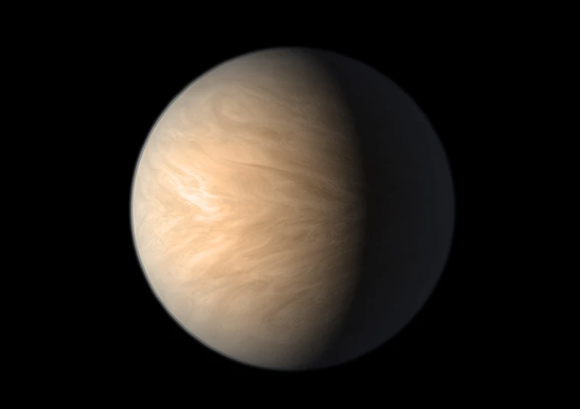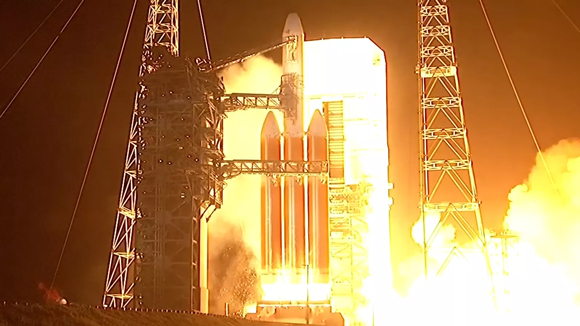An important agreement for Ramon.Space, a near-final launch of the Delta rocket and disappointment over the lack of atmosphere around an intriguing exoplanet. This Week in Space
Israeli Space Computers Go Global
Israeli company Ramon.Space has signed a strategic partnership agreement with Ingrasys, a Taiwanese computer manufacturer and subsidiary of the global conglomerate Foxconn. The agreement aims to facilitate a high-volume production of advanced Israeli space computing technology.
"Ingrasys is developing with us a production line for space computers based on our expertise, adhering to rigorous standards and particularly meticulous inspection procedures. We are sharing our knowledge and gaining a production line for our products at their facility under preferential conditions. This line is being set up in Taiwan, and if there are sizable orders, similar production lines might later be established in other countries, according to customer needs," said president and founder of Ramon.Space, Professor Ran Ginosar, in a conversation with the Davidson Institute website. "Until now, we've been a system company, but we didn’t work with a fixed manufacturer. With a conglomerate of this magnitude backing us, we expect to gain entry into major space organizations. It's a significant boost to our ability to export space computer technologies."
Ramon.Space specializes in the development and manufacturing of space mission computers, specifically designed to withstand the harsh conditions of outer space. These computers are built to operate in environments characterized by vacuum, extreme temperatures, high radiation levels, and more. In addition to producing entire computer systems, Ramon.Space also integrates its chips into various devices designed for space missions, such as cameras, sensors, and communication systems. Ramon.Space components have already been successfully utilized in multiple spacecraft, including Japan's Hayabusa-2, which collected samples from an asteroid, NASA's Solar Orbiter, and the European Space Agency's Jupiter Icy Moons Explorer (Juice). The company is also set to provide a computer for the Genesis 2 mission, which will be the second Israeli attempt at landing a spacecraft on the moon. With a current workforce of approximately seventy individuals, primarily located in Israel and at its headquarters in California, Ramon.Space anticipates further growth prospects following this new partnership agreement.
"Ingrasys is the world's largest manufacturer of computer servers and data center equipment. Their entry into the space market through our collaboration will provide a tremendous boost to the entire space industry, indicating a significant business opportunity in the field of space computing," commented Avi Shabtai, CEO of Ramon.Space, in an interview with the Davidson Institute website. "Having such a player supporting us enables us to develop the world's largest production line for space computer chips, allowing us to produce a product of equal or even higher quality without increasing costs." "Ingrasys is the world's largest manufacturer of computer servers and data center equipment. Our success in bringing such a company into the space market will provide a tremendous boost to the entire space industry, as it signifies their recognition of a substantial business opportunity in space computing" Ramon.Space CEO, Avi Shabtai, told the Davidson Institute website. "Having such a player behind us allows us to develop the world's largest production line for space computer chips, enabling us to produce a product of equal, if not superior, quality without increasing its costs."
Shabtai further emphasized that Ramon.Space's computer systems cater to three main customer segments. Firstly, they serve manufacturers of communication satellites, including both individual units and entire constellations that require substantial computing power while operating in space, Secondly, the company addresses the needs of remote sensing and imaging satellite manufacturers who seek large data storage capacities and on-board image processing capabilities that allow for efficient data handling directly on the satellite itself. Lastly, Ramon-Space targets companies involved in satellite network development, where satellites act as communication relay stations between network satellites. Looking ahead, the industry may witness the emergence of satellites or satellite networks functioning as space data centers. This advancement could potentially eliminate the necessity of transmitting all information back to Earth, opening up new possibilities for data processing and storage in space.
"Our vision is that a single type of hardware will cater to all these platforms, leveraging the advantage of a production line," emphasized Shabtai. "Hence, we were in search of such a manufacturer as a strategic partner, and I estimate that the first chips will come out of this production line within a few months."
According to Ginosar, the strategic partnership agreement signed by Ramon.Space holds significant advantages for the entire Israeli space industry. He stated, "This agreement opens up numerous opportunities in the global space industry, allowing us to bring Israeli computers to many space missions. Rather than being one-off products, we can now offer them in larger quantities, potentially reaching tens, hundreds, or even thousands of units, as is the case in the NewSpace industry.” Ginosar further added that this collaboration could pave the way for more Israeli companies to enter the market and provide a competitive edge to the entire satellite industry in Israel.

A great leverage of capabilities. Ramon.Space computers against the backdrop of Earth from space | Illustration: Ramon.space
An Atmospheric Disappointment
In 2017, scientists made a remarkable discovery of seven Earth-like exoplanets orbiting a diminutive star known as Trappist-1, situated approximately 40 light-years away from us. In cosmic terms, this is virtually within our neighborhood, although given our current technological capabilities, a journey to Trappist-1 would require hundreds of thousands of years. The discovery sparked excitement within the scientific community and was particularly due to the fact that three of these exoplanets are situated within the habitable zone. The habitable zone refers to the region around a star where conditions may allow for the presence of liquid water on a planet’s surface, at least within a suitable temperature range.
However, the potential presence of water on these exoplanets is contingent upon various factors, with one of the most critical factors being the existence of a suitable atmosphere. Without a protective atmosphere, any water present on these planets would quickly evaporate and dissipate into space. The discovery of these exoplanets initially relied on indirect measurements, and they were therefore designated as priority targets for the then-yet-to-launch James Webb Space Telescope. The primary objective of the telescope was to perform direct observations and analyze the atmospheric composition of these exoplanets using its advanced instruments.
In observations conducted at the end of last year, researchers initially focused on the exoplanet in closest proximity to its star, Trappist-1b. Given that this star emits a substantial amount of ultraviolet radiation, potent enough to break down atmospheric gases, it came as no surprise when the findings revealed the absence of a detectable atmosphere around Trappist-1b. However, the researchers held greater expectations for the second exoplanet in the system, Trappist-1c, as it orbits at a greater distance from its star.
To their great disappointment, the recently published data in the Nature journal has revealed that the surface temperature of this exoplanet, Trappist-1c, on the side facing its star, reaches a scorching 107 degrees Celsius, making it unsuitable for supporting a substantial carbon dioxide-rich atmosphere, as they had hoped to find. In fact, the data suggests that Trappist-1c appears to have no atmosphere whatsoever. Comparison of the collected data with chemical models of exoplanet development suggested that Trappist-1c likely never harbored significant amounts of water, or may have only had trace amounts. This discovery significantly diminishes the prospects for life similar to ours to have emerged or thrived there, or that conditions necessary for the development of such lifeforms ever existed there.
Given the relative commonality of such exoplanets, "that would definitely reduce the amount of planets which might be habitable” said one of the paper's authors, Sebastian Zieba, an exoplanet researcher at the Max Planck Institute for Astronomy in Heidelberg, Germany. Nevertheless, the researchers maintain hope regarding the exoplanets located at greater distances from the star. In an article that is yet to undergo peer review, recently shared on the early publication site arXiv, a U.S. researcher suggests that, considering the levels of ultraviolet radiation, the fourth and fifth exoplanets orbiting Trappist-1 could offer more promising prospects for the potential presence of conditions conducive to life.

Hopes of discovering a substantial atmosphere have dissipated into space, likely due to ultraviolet radiation. An An artist's rendering of the exoplanet Trappist-1c | Source: NASA/JPL-Caltech
End of the Delta Era
The American Delta IV Heavy launch vehicle was successfully launched for the second to last time, with only one more launch of such a rocket scheduled. The rocket, built by the American company ULA, launched from the Space Force base at Kennedy Space Center in Florida, carrying the NROL-68 satellite of the National Reconnaissance Office (NRO), which operates reconnaissance and remote sensing satellites for the U.S. intelligence system.
The Delta IV Heavy is the world's third-ranked launch vehicle in terms of thrust power, trailing behind NASA's SLS and SpaceX's Falcon Heavy, but slightly surpassing the Chinese Long March 5. SpaceX's Super Heavy rocket, which is set to carry the Starship spacecraft into space, is expected to be far more powerful than all of these, but it has yet to reach space.

Completing 15 successful launches. Delta IV Heavy launches NROL-68 reconnaissance satellite from Florida, June 22, 2023 | Photo: ULA
Thursday’s launch marked the 43rd launch of a Delta IV series rocket, and the 15th of its heavy configuration, designed for particularly large payloads. All Heavy launches have been successful, save for a partial failure during the first launch. Among other payloads, these powerful rockets have launched the Orion spacecraft on its first test flight in 2014, and the Parker Solar Probe in 2018. The final launch of this rocket type is slated to take place during the first quarter of 2024, during which it will carry an NRO reconnaissance satellite. Delta IV rockets are single-use, with neither their first stage nor their boosters being reused.
The Delta IV Heavy, as well as the Atlas V rocket, which is expected to retire in a few years, will likely be replaced by ULA's new Vulcan Centaur rocket. The first launch of the Vulcan Centaur, intended to transport payloads of a similar size, is scheduled for the end of this year. Unlike the Delta rockets, which are hydrogen and oxygen-fueled, the Vulcan Centaur will use methane and oxygen.
Almost the last chance to see. The penultimate launch of the Delta IV Heavy rocket from Cape Canaveral in Florida (the launch itself starts at 23:50):
